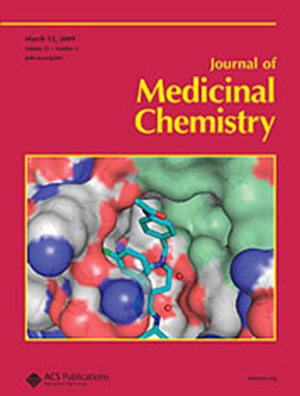Discovery and Evaluation of DA-302168S as an Efficacious Oral Small-Molecule Glucagon-Like Peptide-1 Receptor Agonist
IF 6.8
1区 医学
Q1 CHEMISTRY, MEDICINAL
引用次数: 0
Abstract
Glucagon-like peptide-1 receptor (GLP-1R) holds pivotal importance as a therapeutic target for type 2 diabetes (T2D) and obesity. Several oral small-molecule agonists targeting GLP-1R have been developed to date. Nevertheless, these agonists suffer from several limitations, including low potency, poor pharmacokinetics, and unfavorable safety profiles. Here, we report the discovery of compound 29 (DA-302168S), which exhibits higher potency both in vitro/in vivo while mitigating the risk of drug–drug interaction compared to other reported candidate compounds. Preclinical studies show full efficacy in cAMP activation, glucose reduction, and appetite suppression. Safety assessments reveal minimal risks with hERG IC50 > 30 μM and no significant off-target toxicity. Its favorable pharmacokinetics support once-daily oral dosing, improving patient compliance. These findings suggest that compound 29 offers a promising therapeutic option for the management of T2D and obesity. Notably, it has successfully completed phase I clinical trials and is currently undergoing phase II clinical trials.

DA-302168S作为有效的口服小分子胰高血糖素样肽-1受体激动剂的发现和评价
胰高血糖素样肽-1受体(GLP-1R)作为2型糖尿病(T2D)和肥胖的治疗靶点具有关键的重要性。目前已经开发了几种针对GLP-1R的口服小分子激动剂。然而,这些激动剂存在一些局限性,包括效力低、药代动力学差和不利的安全性。在这里,我们报告了化合物29 (DA-302168S)的发现,与其他已报道的候选化合物相比,它在体外/体内均表现出更高的效力,同时降低了药物-药物相互作用的风险。临床前研究显示对cAMP激活、葡萄糖降低和食欲抑制有充分的疗效。安全性评估显示hERG IC50的风险最小;30 μM,无明显脱靶毒性。其有利的药代动力学支持每日一次口服剂量,提高患者依从性。这些发现表明,化合物29为T2D和肥胖的治疗提供了一个有希望的治疗选择。值得注意的是,它已成功完成I期临床试验,目前正在进行II期临床试验。
本文章由计算机程序翻译,如有差异,请以英文原文为准。
求助全文
约1分钟内获得全文
求助全文
来源期刊

Journal of Medicinal Chemistry
医学-医药化学
CiteScore
4.00
自引率
11.00%
发文量
804
审稿时长
1.9 months
期刊介绍:
The Journal of Medicinal Chemistry is a prestigious biweekly peer-reviewed publication that focuses on the multifaceted field of medicinal chemistry. Since its inception in 1959 as the Journal of Medicinal and Pharmaceutical Chemistry, it has evolved to become a cornerstone in the dissemination of research findings related to the design, synthesis, and development of therapeutic agents.
The Journal of Medicinal Chemistry is recognized for its significant impact in the scientific community, as evidenced by its 2022 impact factor of 7.3. This metric reflects the journal's influence and the importance of its content in shaping the future of drug discovery and development. The journal serves as a vital resource for chemists, pharmacologists, and other researchers interested in the molecular mechanisms of drug action and the optimization of therapeutic compounds.
 求助内容:
求助内容: 应助结果提醒方式:
应助结果提醒方式:


